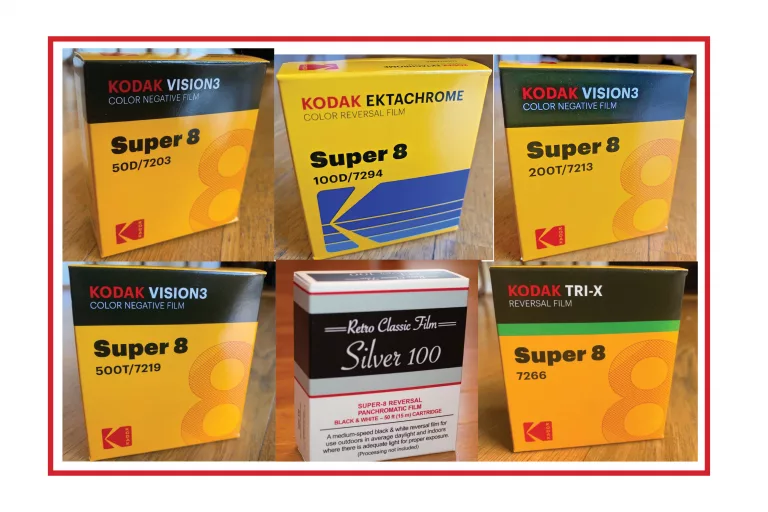
Today there are many different Super-8 movie film stocks to choose from. And like other analog formats that are having a re-discovery (35mm film and vinyl records for example) there may be even more to choose in the coming years. So, how do you choose from among the stocks we have? Many articles will tell you that Super-8 film is full of nostalgia, mainly from those grainy images of yesterday. This is not true. Super-8 film from the 1960s through the 1990s was mostly shot on now-discontinued Kodachrome, which was not grainy in the least bit, and which gave a beautiful sharp image depending on the quality of the camera. The quality of Super-8 film from those decades was excellent, however, there were typically few film stocks to work with, and only two that could produce color. So, the advantage of using Super-8 today comes from the fact that we have many more film stock choices, and that we can digitally scan those images, thereby giving you even more choices as far as color grading, or adding grain if that is what you want.
Choosing the right film today can boil down to a few simple steps. First, you have the choice of reversal film or negative film (something that wasn’t offered in those earlier decades). Think of still pictures: reversal films are like slides, and can be projected on a screen. They can also be digitized, of course, as any film can be digitized. There are not many reversal film choices out there and Kodak Ektachrome 100D is the only color option. Ektachrome 100D will give you the closest look to that nostalgic Kodachrome look. The other choices are all negative films. Unlike reversal films, which have a pretty narrow range when it comes to exposing properly), negative film gives you plenty of latitude when it comes to exposure. Is your lighting just a little too bright or just a little too dark? This is not a problem for negative film. Negative film is the choice for Hollywood when they choose 35mm film, and Kodak’s Super-8 film choices are the exact same films used by the popular directors today. So, if you are after the Hollywood “film look,” negative film is what you want. Negative film is by far the most popular choice of all Super-8 films sold today.
Another choice you have to make is that of color, or black and white. This should be a pretty simple choice to make without needing any explanation. Then there is the choice of film sensitivity, which is measured in terms of ISO speeds. The higher the ISO, the more sensitive to light the film is, meaning it can be used in lower lighting conditions. There is a trade-off, of course. The more sensitive a film is to light, the more grain you will see. Kodak has done a pretty good job of keeping the grain to a minimum in all their films, but needless to say, there is more grain with every increase in the ISO number. The most common ISOs you see nowadays are 100, 200, and 500, which are higher than the old Super-8 films of the past. Often, these films can be pushed (under exposed and overdeveloped in the lab) to double these numbers – giving an incredible range of possibilities from shooting in bright sun to night-time shooting using only available lighting. Often a movie may use a combination of stocks with different ISO speeds, depending on the lighting conditions. If the available light you are working with is quite a bit less in some scenes than others in your movie, you probably will need to either change the film stock to one with a higher ISO, or else bring in artificial lighting to compensate.
Finally, there are two different color balances to film today: ones that are balanced for daylight color temperatures, and ones that are balanced for tungsten lighting. Both can be used in any lighting condition, but be aware that in order for a tungsten balanced film to have correct colors in daylight, a filter will need to be used on the lens of your camera. The same is true if using a daylight balanced film under tungsten lighting (think incandescent bulbs). Either change your lighting bulbs to a more white-ish daylight temperature, or put a filter on the camera to adjust the color balance. Anytime you use a filter on your camera, you will reduce the light, thereby reducing your effective ISO speed, which is why it might be preferable to have a film stock match your lighting temperature. Most Super-8 cameras have a built-in 85A filter which is used for using tungsten balanced film in daylight conditions.
Even though Super-8 film can be expensive when adding the cost of the film, plus processing and scanning, if you are new to all of this, I highly recommend testing out one cartridge of film before embarking on a critical film shoot. Testing out one cartridge can be essential for no other reason than testing out a camera, but it can also be an excellent judge of what to expect from a film stock.
Super 8 Today sells a variety of film stocks in both Super-8 and 16mm formats, including all the Kodak Vision 3 series of negative films, Ektachrome 100D reversal film, and a few black & white reversal films.